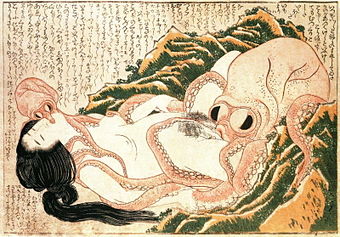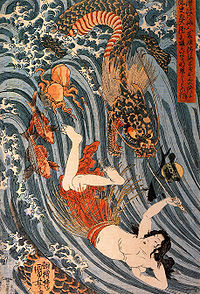- The Dream of the Fisherman's Wife
-
The Dream of the Fisherman's Wife Japanese: Tako to ama 
Artist Hokusai Year 1814 The Dream of the Fisherman's Wife (蛸と海女 Tako to ama, literally Octopus and shell diver), also known as Girl Diver and Octopi, Diver and Two Octopi, etc., is an erotic woodcut of the ukiyo-e genre by the Japanese artist Hokusai. It is from the book Kinoe no Komatsu (English: Young Pines), a three-volume collection of shunga erotic prints first published in 1814, and is the most famous shunga Hokusai ever produced. Playing with themes popular in contemporary Japanese art, it depicts a young ama diver entwined sexually with a pair of octopuses.
Contents
History and description
The Dream of the Fisherman's Wife is the most famous image in Kinoe no Komatsu, published in three volumes from 1814, during the Edo period. The book is a collection of shunga, a form of erotic art popularized by the ukiyo-e movement.[1] The image, Hokusai's most famous shunga, depicts a woman, evidently an ama (a shell diver), enveloped in the arms of two octopuses. The larger of the two mollusks performs cunnilingus on her, while the smaller one, perhaps his son, assists on the left by fondling her mouth and nipple. In the text above the image the woman and the creatures express their mutual sexual pleasure from the encounter.[2] The text reads, in part:
- MAIDEN: You hateful octopus! Your sucking at the mouth of my womb makes me gasp for breath! Aah! yes... it's... There.!!! With the sucker, the sucker!! Inside, squiggle, squiggle, Oooh! Oooh, good, Oooh good! There, there! Theeeeere! Goood! Whew! Aah! Good, good, Aaaaaaaaaah! Not yet! Until now it was I whom men called an octopus! An octopus! Ooh! Whew! How are you able...!? Ooh! "yoyoyooh, Saa... Hicha hicha gucha gucha, yuchyuuchyu guzu guzu suu suuu...."[3]
The work is untitled in the collection; it is generally known as Tako to ama in Japanese, translated variously into English. Richard Douglas Lane calls it Girl Diver and Octopi;[4] Mathi Forrer calls it Pearl Diver and Two Octopi;[5] and Danielle Talerico calls it Diver and Two Octopi.[6]
Interpretations
Scholar Danielle Talerico notes that the image would have recalled to the minds of contemporary viewers the story of Princess Tamatori, highly popular in the Edo period.[2] In this story, Tamatori is a modest shell diver who marries Fujiwara no Fuhito of the Fujiwara clan, who is searching for a pearl stolen from his family by Ryūjin, the dragon god of the sea. Vowing to help, Tamatori dives down to Ryūjin's undersea palace of Ryūgū-jō, and is pursued by the god and his army of sea creatures, including octopuses. She cuts open her own breast and places the jewel inside; this allows her to swim faster and escape, but she dies from her wound soon after reaching the surface.[7]
The Tamatori story was a popular subject in ukiyo-e art. The artist Utagawa Kuniyoshi produced a number of works based on it, which often include octopuses among the creatures being evaded by the bare-breasted diver.[7] In the text above Hokusai's image, the big octopus says he will bring the girl to Ryūjin's undersea palace, strengthening the connection to the Tamatori legend.[6] The Dream of the Fisherman's Wife is not the only work of Edo-period art to depict erotic relations between a woman and an octopus. A number of early netsuke carvings show cephalopods fondling nude women.[8][9] Hokusai's contemporary Yanagawa Shigenobu created an image of a woman receiving cunnilingus from an octopus very similar to Hokusai's in his collection Suetsumuhana of 1830.[10]
Talerico notes that earlier Western critics such as Edmond de Goncourt and Jack Hillier interpreted the work as a rape scene. However, she notes that these scholars would have seen it apart from the Kinoe no Komatsu collection and without understanding the text and visual references, depriving it of its original context.[6] According to Chris Uhlenbeck and Margarita Winkel, "[t]his print is testimony to how our interpretation of an image can be distorted when seen in isolation and without understanding the text."[2]
Influence
The Dream of the Fisherman's Wife is often cited as an early forerunner of tentacle erotica, a motif that has been common in modern Japanese animation and manga since the late 20th century. Modern tentacle erotica similarly depicts sex between human women and tentacled beasts; notably, however, the sex in modern depictions is typically forced, as opposed to Hokusai's mutually pleasurable interaction.[11] Psychologist and critic Jerry S. Piven, however, is skeptical that Hokusai's playful image could account for the violent depictions in modern media, arguing that these are instead a product of the turmoil experienced throughout Japanese culture following World War II.[12] However, scholar Holger Briel argues that "only in a society that already has a predilection for monsters and is used to interacting with octopods such images might arise," citing Hokusai's print an early exemplar of such a tradition.[11]
The work has influenced a number of later artists such as Félicien Rops, Auguste Rodin, Louis Aucoc, Fernand Khnopff, and Pablo Picasso.[13] Picasso painted his own version in 1903 that has been shown next to Hokusai's original in exhibits on the influence of 19th-century Japanese art on Picasso's work.[14] In 2003 a derivative work by Australian painter David Laity, also titled "The Dream of the Fisherman's Wife", sparked a minor obscenity controversy when it was shown at a gallery in Melbourne; after receiving multiple complaints Melbourne police investigated, but determined it did not break the city's pornography laws.[15][16] Hokusai's print has had a wide influence on the modern Japanese-American artist Masami Teraoka, who has created a number of images of women, including a recurring "pearl diver" character, being pleasured by cephalopods as a symbol of female sexual power.[17]
The so-called "aria della piovra" ("Octopus aria") "Un dì, ero piccina" in Pietro Mascagni's opera Iris (1898), on a libretto by Luigi Illica, may have been inspired by this print. The main character Iris describes a screen she had seen in a Buddhist temple when she was a child, depicting an octopus coiling its tentacles around a smiling young woman and killing her. She recalls a Buddhist priest explaining: "That octopus is Pleasure... That octopus is Death!"[18]
Notes
- ^ Uhlenbeck, p. 56; 161.
- ^ a b c Uhlenbeck, p. 161.
- ^ James Heaton and Toyoshima Mizuho. "Erotic Expression in Shunga". Kyoto Journal 18, 1991.
- ^ Lane, p. 163
- ^ Forrer, p. 124
- ^ a b c Talerico 24-42.
- ^ a b Miller, p. 137.
- ^ Schwarz, pp. 96–97.
- ^ Symmes, p. 132.
- ^ Lenehan-White, Anne. "Shunga and Ukiyo-e: Spring Pictures and Pictures of the Floating World". www.stolaf.edu. http://www.stolaf.edu/people/kucera/YoshidaWebsite/evolution/essay_pages/anne_lenehan_white.htm. Retrieved November 6, 2010.
- ^ a b Briel, p. 203.
- ^ Piven, p. 110–111.
- ^ Bru, pp. 55–77.
- ^ "Picasso's Japanese erotic inspiration on show in Barcelona". The Independent. November 6, 2009. http://www.independent.co.uk/arts-entertainment/art/news/picassos-japanese-erotic-inspiration-on-show-in-barcelona-1815988.html. Retrieved December 3, 2010.
- ^ "Picasso's Japanese erotic inspiration on show in Barcelona". The New Zealand Herald. New Zealand Press Association. Oct 21, 2003. http://www.nzherald.co.nz/world/news/article.cfm?c_id=2&objectid=3529966. Retrieved December 14, 2010.
- ^ Fickling, David (Oct 22, 2003). "Melbourne row over art 'porn'". The Guardian. http://www.guardian.co.uk/world/2003/oct/22/arts.australia. Retrieved December 3, 2010.
- ^ Bing, pp. 44–47.
- ^ Mallach, p. 127 and note.
References
- Bing, Alison; Eleanor Heartney and Kathryn Hoffman (2006). The madness and perversion of Yukio Mishima. Chronicle Books. ISBN 0811850978. http://books.google.com/books?id=xllWkNRukCQC&printsec=frontcover&source=gbs_ge_summary_r&cad=0#v=onepage&q&f=false. Retrieved December 3, 2010.
- Briel, Holger (2010). "The Roving Eye Meets Traveling Pictures: The Field of Vision and the Global Rise of Adult Manga". In Berninger, Mark; Ecke, Jochen; and Haberkorn, Gideon, Comics As a Nexus of Cultures: Essays on the Interplay of Media, Disciplines, pp. 187–210. McFarland. ISBN: 0786439874Retrieved November 9, 2010.
- Bru, Ricard (2010). "Tentacles of love and death: from Hokusai to Picasso". Secret Images. Picasso and the Japanese Erotic Print, Thames & Hudson, London, pp. 50-77.
- Forrer, Mathi (1992). Hokusai: Prints and Drawings.
- Lane, Richard (1978). Images from the Floating World, The Japanese Print. Oxford: Oxford University Press. 10-ISBN 0192114476/13-ISBN 9780192114471; OCLC 5246796
- Lenehan-White, Anne. "Shunga and Ukiyo-e: Spring Pictures and Pictures of the Floating World". www.stolaf.edu. http://www.stolaf.edu/people/kucera/YoshidaWebsite/evolution/essay_pages/anne_lenehan_white.htm. Retrieved November 6, 2010.
- Mallach, Alan (2002). Pietro Mascagni and his Operas. UPNE. http://books.google.com/books?id=kUCtUcFvr0IC&printsec=frontcover&source=gbs_ge_summary_r&cad=0#v=onepage&q&f=false. Retrieved July 8, 2011.
- Piven, Jerry S. (2004). The madness and perversion of Yukio Mishima. Greenwood Publishing Group. ISBN 0275979857. http://books.google.com/books?id=ci9jlzhuIBQC&printsec=frontcover&source=gbs_ge_summary_r&cad=0#v=onepage&q&f=false. Retrieved November 11, 2010.
- Schwarz, Karl M. (1995). Netsuke Subjects: A Study on the Netsuke Themes with Reference to their Interpretation and Symbolism. Tuttle Publishing. ISBN 0804820260. http://books.google.com/books?id=WWgh3P7OFyUC&printsec=frontcover&source=gbs_ge_summary_r&cad=0#v=onepage&q&f=false. Retrieved November 10, 2010.
- Symmes, Edwyn C. (1995). Netsuke: Japanese Life and Legend in Miniature. Böhlau Verlag Wien. ISBN 3205055152. http://books.google.com/books?id=y1GXEdmo-hcC&printsec=frontcover&source=gbs_ge_summary_r&cad=0#v=onepage&q&f=false. Retrieved November 10, 2010.
- Talerico, Danielle (2001). “Interpreting Sexual Imagery in Japanese Prints: A Fresh Approach to Hokusai’s Diver and Two Octopi”. In Impressions, The Journal of the Ukiyo-e Society of America, Vol. 23.
- Uhlenbeck, Chris; Margarita Winkel, Ellis Tinios, Amy Reigle Newland (2005). Japanese Erotic Fantasies: Sexual Imagery of the Edo Period. Hotei. ISBN 9074822665.
Categories:- 1814 works
- Erotic art
- Fictional octopuses
- Ukiyo-e
Wikimedia Foundation. 2010.


